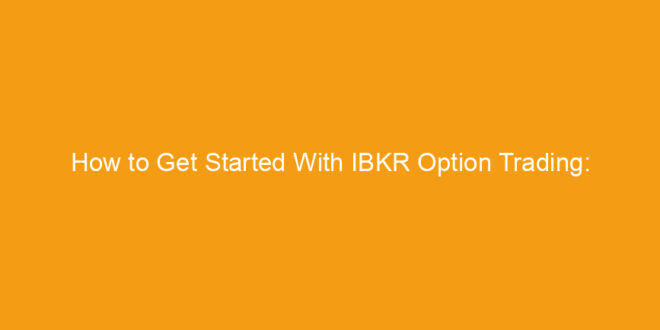Starting to trade options with Interactive Brokers (IBKR) can be a great way to diversify your portfolio and access a variety of different markets. Before you get started, it’s important to understand the requirements and the steps you’ll need to take to become an options trader.
Requirements
The first step in getting started with IBKR options trading is to meet the requirements. To be eligible to trade options with IBKR, you must have a minimum of USD 10,000 in your account. Additionally, you must have a minimum of USD 2,000 in equity and/or options in your account.
You’ll also need to read and accept the Options Trading Agreement, which outlines the terms of trading options with IBKR. You’ll also need to agree to the Brokerage Account Agreement, which outlines the general terms and conditions for having a brokerage account with IBKR.
Steps
Once you’ve met the requirements to trade options with IBKR, you’ll need to take a few steps to get started.
- Request Approval. You’ll need to submit a request to get approved to trade options with IBKR. This can be done through the IBKR website or by calling IBKR’s customer service team.
- Place an Order. Once your request has been approved, you’ll be able to place an order to buy or sell options.
- Monitor Your Positions. It’s important to monitor your positions to make sure that they’re performing as expected. You can use IBKR’s tools and resources to help you stay on top of your positions.
- Close Your Positions. Once you’ve decided to close your positions, you’ll need to submit an order to do so.
By following these steps, you’ll be able to start trading options with IBKR. Before you get started, it’s important to understand the risks associated with options trading, as well as the potential rewards. With the right strategy, trading options with IBKR can be a great way to diversify your portfolio and access a variety of different markets.
Understanding the Margin Requirements of IBKR Option Trading
The margin requirements of Interactive Brokers (IBKR) for option trading are designed to ensure that the customer has adequate funds to cover any losses from their option trades. Understanding the margin requirements is essential for successful option trading.
At IBKR, margin requirements are determined by the underlying security and the option strike price. When trading options, the margin requirement can vary depending on the type of option and the option’s strike price. Margin requirements are set based on the risk associated with the particular option contract and the current market price of the underlying security.
For long option positions, customers must maintain a margin requirement equal to the greater of the option premium or the intrinsic value of the option, plus 20% of the option’s underlying security value. For example, if the strike price of an option is $50 and the security is trading at $60, then the intrinsic value of the option is $10. The margin requirement will be the greater of the option premium or $10, plus 20% of the underlying security value.
For short option positions, customers must maintain a margin requirement equal to the greater of the option premium or the intrinsic value of the option, plus 100% of the option’s underlying security value. For example, if the strike price of an option is $50 and the security is trading at $60, then the intrinsic value of the option is $10. The margin requirement will be the greater of the option premium or $10, plus 100% of the underlying security value.
In addition, if the option is deep in-the-money, the margin requirement may be higher. To calculate the margin requirement for deep in-the-money options, customers must add 20% of the underlying security’s value to the intrinsic value of the option.
Finally, customers should be aware that IBKR may increase margin requirements for certain options trades if the market moves against them. Customers should monitor their margin requirements and make sure that they have enough funds to cover any additional margin requirements.
By understanding the margin requirements for IBKR option trading, customers can ensure that they have adequate funds to cover any losses from their option trades.
Using the Risk Management Tools of IBKR Option Trading to Manage Risks and Maximize Returns
Risk management is an essential part of trading options, and the Interactive Brokers (IBKR) option trading platform offers a range of tools to help traders manage risk and maximize returns. The suite of risk management tools available in IBKR includes portfolio margining, volatility protection, and pattern recognition.
Portfolio margining is a tool that allows traders to calculate the total margin requirement for a portfolio of options positions. Traders can use this tool to view the margin requirements across their entire portfolio as well as determine the margin requirements for each position. This helps traders to ensure that they have adequate capital to cover their trades, and also allows them to adjust their positions if necessary in order to reduce their margin requirements.
Volatility protection is a risk management tool that helps traders protect their positions from large price fluctuations. This tool allows traders to set a maximum price movement for the options they are trading, and if the price exceeds this level, the position will be closed automatically. This helps traders to protect their positions from unforeseen market events, and also helps to reduce their overall risk exposure.
Finally, IBKR’s pattern recognition tool helps traders to identify potential trading opportunities. This tool scans the options market for pre-defined patterns such as condors, butterflies, and straddles, and then provides traders with suggested trades. By using this tool, traders can quickly identify potentially profitable trades and take advantage of them before the market moves too far.
In conclusion, IBKR’s suite of risk management tools can help traders to reduce their risk exposure and maximize their returns. By using these tools, traders can better manage their positions and take advantage of opportunities as they arise.

